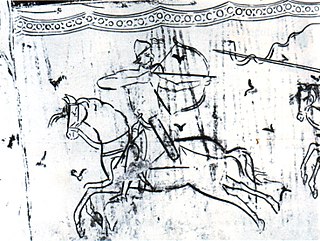 W
WThe Battle of Achelous or Acheloos, also known as the Battle of Anchialus, took place on 20 August 917, on the Achelous river near the Bulgarian Black Sea coast, close to the fortress Tuthom between Bulgarian and Byzantine forces. The Bulgarians obtained a decisive victory which not only secured the previous successes of Simeon I, but made him de facto ruler of the whole Balkan Peninsula, excluding the well-protected Byzantine capital Constantinople and the Peloponnese.
 W
WThe Battle of Brenta was fought between the cavalry of the Kingdom of Italy under king Berengar I and the Hungarians, hired by the East Francian king Arnulf of Carinthia, against him, at an unidentified location in northern Italian Peninsula along the river Brenta on 24 September 899. It was one of the earliest battles of the Hungarian invasions of Europe. The result was a crushing defeat for Berengar I, opening the following raids for the Hungarians against Italy. The Hungarian invasion resulted in the burning of many cities, like Feltre, Vercelli, Modena and monasteries like the monastery in Nonantola, and attacking even Venice, however without success.
 W
WThe Battle of Drava River was fought between the army of Tomislav of Croatia and the forces of Hungarian tribes led by Grand Prince Zoltán, the youngest son of Árpád, founder of the Árpád dynasty.
 W
WAccording to the dubious Chronicle of the Priest of Duklja, a Magyar leader named Kisa led an invasion into Bosnia, where he was decisively defeated by Časlav, the Prince of Serbia, somewhere on the Drina. Kisa's widow requested from the Magyar chief to give her another army to avenge his death. With an "unknown number" of troops, the widow went for Časlav, encountering him somewhere in Syrmia. In the night, the Magyars attacked the Serbs, captured Časlav and all of his male relatives. On the command of the widow, all of them were bound by their hands and feet and thrown into the Sava river. Vladimir Ćorović dates this event to c. 960.
 W
WThe first Battle of Lechfeld, fought on 12 June 910, was an important victory by a Magyar army over the combined forces of East Francia and Swabia (Alamannia) under the nominal command of Louis the Child. Located approximately 25 km (15.53 mi) south of Augsburg, the Lechfeld is the floodplain that lies along the river Lech. At this time the Grand Prince of the Hungarians was Zoltán, but there is no record of him taking part in the battle.
 W
WThe Battle of Lechfeld was a series of military engagements over the course of three days from 10–12 August 955 in which the Kingdom of Germany led by king Otto I the Great annihilated the Hungarian army led by harka Bulcsú and the chieftains Lél and Súr. With this German victory further invasions by the Magyars into Latin Europe were ended.
 W
WThe Battle of Pressburg or Battle of Pozsony, or Battle of Bratislava was a three-day-long battle, fought between 4–6 July 907, during which the East Francian army, consisting mainly of Bavarian troops led by Margrave Luitpold, was annihilated by Hungarian forces.
 W
WThe Battle of Riade or Battle of Merseburg was fought between the troops of East Francia under King Henry I and the Magyars at an unidentified location in northern Thuringia along the river Unstrut on 15 March 933. The battle was precipitated by the decision of the Synod of Erfurt to stop paying an annual tribute to the Magyars in 932.
 W
WAccording to the dubious Chronicle of the Priest of Duklja, a Magyar leader named Kisa led an invasion into Bosnia, where he was decisively defeated by Časlav, the Prince of Serbia, somewhere on the Drina. Kisa's widow requested from the Magyar chief to give her another army to avenge his death. With an "unknown number" of troops, the widow went for Časlav, encountering him somewhere in Syrmia. In the night, the Magyars attacked the Serbs, captured Časlav and all of his male relatives. On the command of the widow, all of them were bound by their hands and feet and thrown into the Sava river. Vladimir Ćorović dates this event to c. 960.
 W
WThe Battle of Wels was fought between a joint Bavarian–Carantanian army and a Hungarian force near Wels in the Traungau, on the plain of the Welser Heide, nowadays a part of Austria. The battle took place at the height of the Hungarian invasions of Europe. The Bavarians and Carantanians were victorious under the command of the Bavarian leader Berthold. The victory is mentioned widely in contemporary histories. It is mentioned in Widukind of Corvey's Deeds of the Saxons, in Hermann of Reichenau's Chronicon and by Adalbert of Weissenburg in his continuation of the Chronicon of Regino of Prüm. It is also mentioned in the Annals of Saint Gall, the Annals of Salzburg and the Annals of Magdeburg, and in the necrology of Freising Cathedral.